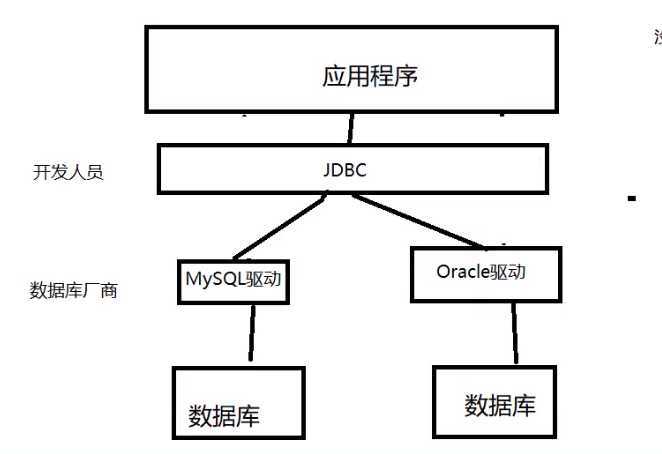应用程序和数据库无法直接挂钩,所以就需要一个驱动。这个驱动是由数据库厂商提供的。
每个数据库都有一个对应的驱动。
SUN公司为了简化数据的操作,提供了一个规范,俗称jdbc。
jdbc是驱动和驱动之间的部分。这里用5.1.47的驱动版本。
https://www.mvnjar.com/mysql/mysql-connector-java/5.1.47/detail.html

问题
链接数据库步骤:
问题:

原因:连接数据库的顺序必须是url,user,password。顺序反了不可以。
package JDBCTest;
import java.sql.*;
public class JdbcDemo01 {
public static void main(String[] args) throws ClassNotFoundException, SQLException {
//1.加载数据库驱动
Class.forName ("com.mysql.jdbc.Driver");
//2.用户名,地址,密码
String user = "root";
String password = "123456";
String url = "jdbc:mysql://localhost:3306/school?useUnicode=true&characterEncoding=utf8&useSSL=true";
//3.获取数据库连接
Connection connection = DriverManager.getConnection (url,user,password);
//4.获取sql语句对象
Statement statement = connection.createStatement ();
//5。使用的sql语句
String sql = "select * from studentInfo";
//6.执行SQL语句,获取结果集
ResultSet resultSet = statement.executeQuery (sql);
while (resultSet.next ()){
System.out.println ("学生的id"+resultSet.getObject ("id"));
System.out.println ("学生的姓名"+resultSet.getObject ("name"));
System.out.println ("学生的号码"+resultSet.getObject ("phoneNum"));
System.out.println ("学生的地址"+resultSet.getObject ("address"));
}
connection.close ();
statement.close ();
resultSet.close ();
}
}
connection对象可以执行很多操作。
statement执行sql对象。
ResultSet只有查询才有。ResultSet.beforeFirst();ResultSet.afterLast();移动迭代时候的光标
问题:
driver=com.mysql.jdbc.Driver
url=jdbc:mysql://localhost:3306/school?useUnicode=true&characterEncoding=utf8&useSSL=true
username=root
password=123456
package JDBCTest.utils;
import java.io.IOException;
import java.io.InputStream;
import java.sql.*;
import java.util.Properties;
public class JdbcUtils {
private static String driver = null;
private static String url = null;
private static String username = null;
private static String password = null;
static {
try{
InputStream in = JdbcUtils.class.getClassLoader ().getResourceAsStream ("db.properties");
Properties properties = new Properties ();
properties.load (in);
driver = properties.getProperty ("driver");
url = properties.getProperty ("url");
username = properties.getProperty ("username");
password = properties.getProperty ("password");
Class.forName (driver);
} catch (IOException | ClassNotFoundException e) {
e.printStackTrace ();
}
}
//获取连接
public static Connection getConnection() throws SQLException {
return DriverManager.getConnection (url,username,password);
}
//释放资源
public static void release(Connection connection, Statement statement, ResultSet resultSet){
if(resultSet!=null){
try {
resultSet.close ();
} catch (SQLException e) {
e.printStackTrace ();
}
}
if(statement!=null){
try {
statement.close ();
} catch (SQLException e) {
e.printStackTrace ();
}
}
if(connection!=null){
try {
connection.close ();
} catch (SQLException e) {
e.printStackTrace ();
}
}
}
}
package JDBCTest.utils;
import java.sql.Connection;
import java.sql.ResultSet;
import java.sql.SQLException;
import java.sql.Statement;
public class TestDelete {
public static void main(String[] args) {
Connection connection = null;
Statement statement = null;
ResultSet resultSet = null ;
try{
connection = JdbcUtils.getConnection ();
statement=connection.createStatement ();
String sql =" DELETE FROM `school`.`studentinfo` WHERE `id` = ‘100001‘";
int i = statement.executeUpdate (sql);
if (i>0){
System.out.println ("删除成功!");
}
} catch (SQLException e) {
e.printStackTrace ();
}finally {
JdbcUtils.release (connection,statement,resultSet);
}
}
}
public static void main(String[] args) {
Connection connection = null;
Statement statement = null;
ResultSet resultSet = null ;
try{
connection = JdbcUtils.getConnection ();
statement=connection.createStatement ();
String sql ="INSERT INTO `school`.`studentinfo` (`id`, `name`, `phoneNum`, `address`) VALUES (‘10002‘, ‘BigFace‘, ‘10000‘, ‘安徽六安‘)";
int i = statement.executeUpdate (sql);
if (i>0){
System.out.println ("插入成功!");
}
} catch (SQLException e) {
e.printStackTrace ();
}finally {
JdbcUtils.release (connection,statement,resultSet);
}
}
package JDBCTest.utils;
import java.sql.Connection;
import java.sql.ResultSet;
import java.sql.SQLException;
import java.sql.Statement;
public class TestUpdate {
public static void main(String[] args) {
Connection connection = null;
Statement statement = null;
ResultSet resultSet = null;
try{
connection = JdbcUtils.getConnection ();
statement =connection.createStatement ();
String sql = "UPDATE `school`.`studentinfo` SET `phoneNum` = ‘10010‘ WHERE `id` = ‘10002‘ ";
int i = statement.executeUpdate (sql);
if (i>0){
System.out.println ("更新数据成功!");
}
} catch (SQLException e) {
e.printStackTrace ();
}finally {
JdbcUtils.release (connection,statement,resultSet);
}
}
}
利用字符串拼接,来获取数据库全部输入而绕过登录
https://baike.baidu.com/item/sql%E6%B3%A8%E5%85%A5/150289?fr=aladdin
package JDBCTest.utils;
import java.sql.Connection;
import java.sql.ResultSet;
import java.sql.SQLException;
import java.sql.Statement;
public class SqlInjectionAttack {
public static void login(String username,String password){
Connection connection = null;
Statement statement = null;
ResultSet resultSet = null ;
try{
connection = JdbcUtils.getConnection ();
statement=connection.createStatement ();
// SELECT * FROM `studentinfo` WHERE `name`=‘李欢欢‘ AND `phoneNum`=10086
String sql ="SELECT * FROM `studentinfo` WHERE `name`=‘"+username+"‘ AND `password`=‘"+password+"‘";
resultSet=statement.executeQuery (sql);
while (resultSet.next ()){
System.out.println (resultSet.getString ("name"));
System.out.println (resultSet.getString ("password"));
}
} catch (SQLException e) {
e.printStackTrace ();
}finally {
JdbcUtils.release (connection,statement,resultSet);
}
}
public static void main(String[] args) {
// login("李欢欢","10000");
// SELECT * FROM `studentinfo` WHERE `name`=‘李欢欢‘ or ‘1=1‘ AND `password=10000
login (" ‘or ‘1=1"," ‘or‘1=1");
}
}
优点:避免了SQL注入攻击,效率更高,更安全
package JDBCTest;
import JDBCTest.utils.JdbcUtils;
import java.sql.*;
public class TestDelete1 {
public static void main(String[] args) {
Connection connection = null;
PreparedStatement preparedStatement = null;
try{//使用preparedStatement重写
//1.获取数据库连接
connection = JdbcUtils.getConnection ();
//2.编译sql语句,使用占位符
String sql = " DELETE FROM `school`.`studentinfo` WHERE `id` = ?";
//3.获取PreparedStatement对象,预编译sql
preparedStatement = connection.prepareStatement (sql);
//4.手动设置值
preparedStatement.setInt (1,10000);
//5。执行sql
int i = preparedStatement.executeUpdate ();
if (i>0){
System.out.println ("删除成功!");
}
} catch (SQLException e) {
e.printStackTrace ();
}finally {
JdbcUtils.release (connection,preparedStatement,null);
}
}
}
package JDBCTest;
import JDBCTest.utils.JdbcUtils;
import java.sql.*;
public class TestInsert1 {
public static void main(String[] args) {
Connection connection = null;
PreparedStatement preparedStatement = null;
try{
connection = JdbcUtils.getConnection ();
//1.获取sql语句
String sql ="INSERT INTO `school`.`studentinfo` (`id`, `name`, `phoneNum`, `address`,`password`) VALUES (?,?,?,?,?)";
//2.预编译sql
preparedStatement = connection.prepareStatement (sql);
//3.手动设置值
preparedStatement.setInt (1,10099);
preparedStatement.setString (2,"dashadan");
preparedStatement.setString (3,"19880281");
preparedStatement.setString (4,"北京市");
preparedStatement.setString (5,"Jhj1000");
//执行sql语句
int i = preparedStatement.executeUpdate ();
if (i>0){
System.out.println ("插入成功!");
}
} catch (SQLException e) {
e.printStackTrace ();
}finally {
JdbcUtils.release (connection,preparedStatement,null);
}
}
}
SQL操作的封装,statement与PreparedStatement的区别,SQL注入
原文:https://www.cnblogs.com/li33/p/12813486.html